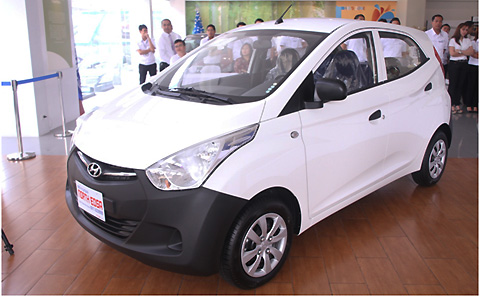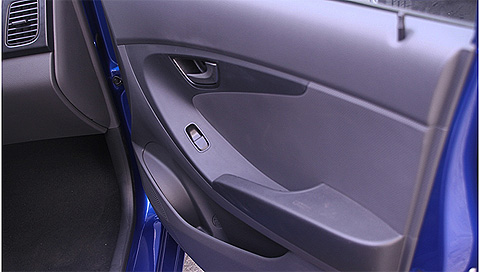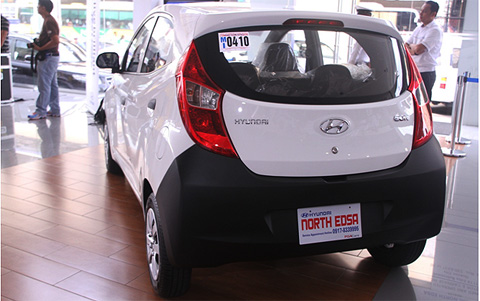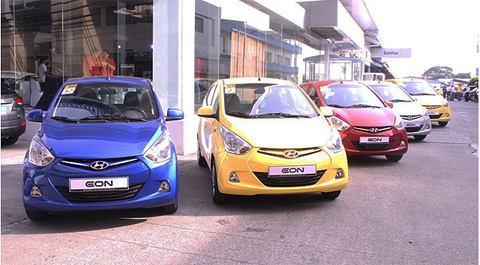Hyundai has been around for quite some time already but has made a fair amount of noise in the car industry recently. The South Korean based car manufacturer has sold more than 3.6 million vehicles last 2010 and ranked 8th largest car manufacturer 2 years before that.
Their recent achievement is bagging the sought-after Car of the Year Award with their new Elantra. Riding this success, Hyundai has yet again aims to catch the attention of consumers in emerging country with their recent compact car offering — the Hyundai Eon.

Hyundai has recently announced this compact car last March of this year at MIAS (Manila International Auto Show). To boost the hype, they followed up the announcement after two months with a 3-day test drive to the country’s summer capital with the members of the media and writers. This trip will not only test its durability and maneuverability, but also its fuel efficiency; which is its main selling point. We’ll post a separate article for that in the next coming days.
The Hyundai Eon is a 5-door hatchback which is the company’s contender in the sub-compact category. The minimalistic European-inspired design of the car is coupled with smooth flowing curves that gives it a simple but elegant appeal. In addition, these curves should lessen the drag and improves the overall aerodynamics of the car. The car is available in 9 color varieties, namely — Ember Silver, Coral White, Sleek Silver, Clean Blue, Pristine Blue, Electrix Red, Maharaja Red, Black Diamond and Yellow.

Following the same principle applied on its exterior design, the insides of the Hyundai Eon is simple yet purposeful. You can easily have the car mistaken for having a cramped interior because of its compact design. But this car’s interior is actually spacious enough that you and your passengers can move quite easily in it. The ample legroom both in front at the back of the car ensures a comfortable driving experience even in long trips. Though not as big as the ones on conventional sized cars, the Eon’s compartment is spacious enough to house most of your basic baggage.
This car is equipped with the bare essentials that a typical driver needs in a car. The dashboard is a combination of both analog and digital gauges. On the driver’s right side is the car stereo with USB and Aux port so you can plug a PMP like an iPod. The car also has an SRS airbag on the driver’s side.

On the left door’s arm rest, there are two switches that controls the two front windows. There is also a single switch for that on the right arm rest.Unfortunately these switches are absent on the back and passengers have to deal with manually pulling the windows up and down. The side mirrors are also controlled manually just like in the old days.
This car is equipped with an 814cc Epsilon multi-point injection engine which generates 55bhp and 75Nm of torque clocked at 4000rpm . This 5-speed manual transmission car’s main selling point is its mileage. The Hyundai Eon’s fuel-efficiency is being advertised by the company to be capable of 22km/l on highway driving and 18km/l on city driving, based on their R&D. I’ll make sure to take note of that on our experiential article.

Hyundai ensures a pleasant ride even on bumpy roads by equipping the Eon with MacPherson Strut Type / Torsion Beam Axle. In addition, the car has MDPS (Motor Driven Power Steering) with a minimum turning radius of 4.55m.
Here’s a more detailed specs of the Hyundai Eon:
Displacement: 814cc
Max Power: 5500rpm
Max Torque: 4000rpm
Transmission: Manual 5-speed
Steering: MPDS
Suspension: MacPherson Strut Type / Torsion Beam Axle
Shock Absorber: Oil Type
Brake Type: Disc / Drum
Dimension: 3495 x 1550 x 1500mm
Air-conditioning: Manual, 4-speed fan blower w/ front heater core

There’s really nothing spectacular in the car’s design (exterior and interior) that we haven’t seen in other cars in the same class and price range. You’d simply get what you’d typically expect from an entry-level compact city car, and maybe even more compared to its competitor but I think that its affordability and practicality is what will attract potential budget-conscious consumers to this car.

In addition to this, the Hyundai Eon’s main selling points are how well it manages its fuel resources and its affordability. It gains an edge over its competitor for having a well-built body and decent machinery under the hood for a more competitive price. Aside from the color variant, Hyundai will also offer two variants of this vehicle, GL and GLS. There’s just minor difference between the two, most of which are aesthetics. The GL is priced at Php438,000 while the GLS is Php498,000. Catch our experiential article in a few.




Can i drive this car from Manila to Samar then to tacloban(Riding a barge)
Hi…
Can i drive my EON GL from Laguna to Ilocos Norte?
yes you can even to baguio we’ve been there 3 days ago nad its more fun using my eon GLS 2014
i am planning to buy eon or any hyundai car that fits my budget and needs. I am interested into gas consumption. Can anybody suggest me any hyundai model that is very efficient in gas consumption? please…
I was planning to get an entry car, well im not really fond of having an expensive ones, so i am torn between eon and alto, which one is really better?
Nice car and can carry more than five passenger, 4 in the back set and 2 front set excluding the driver…
Wow that was strange. I just wrote an extremely long comment but after I clicked submit my comment didn’t show up. Grrrr… well I’m not writing all that over
again. Regardless, just wanted to say excellent blog!
I am glad it comes only in manual, if this was AT it may not make it in steep climbs, remember it only has 800cc so manual did it juctice
Primarily because the EON is made in India.
Since the EON is available in india, their price for the top of the line is about 3.8 lakh ruppies, and if my conversion is correct its 284,465 phil pesos only… why cars in india affordable???
Too bad, no A/T variant 🙁
sayang walang A/T.
At 120kph feels like a sedan
So how could I win this?
Looks cramped inside…
Definitely not for tall guys & gals..
Saw this on display at MoA a while back, loved the fact that it was .8L. I would’ve preferred a 600cc Kei car but it seems this is the closest I’ll ever get to one in this country. However, the lack of an A/T model really dissuades me…don’t wanna go back to M/T anymore.
This is one cool car…cheapest so far….but they don’t have it in A/T…so I settled for Suzuki Swift…
Thanks for this sir abe.
Sana madami pang ganito.
Hi may I know the competitor of this eon.
suzuki alto. reviews say eon has better looks, more space while alto is more fuel efficient and better value for money (all factors considered).
Sir Abe, it’s been a while since your last car review here. I really love reading this kind of article aside from the gadgets 🙂